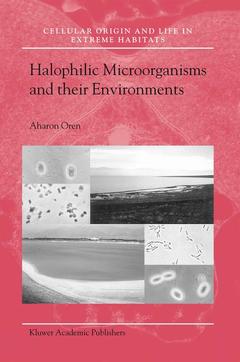Description
Halophilic Microorganisms and their Environments, 2002
Cellular Origin, Life in Extreme Habitats and Astrobiology Series, Vol. 5
Author: Oren Aharon
Language: English
Subjects for Halophilic Microorganisms and their Environments:
Keywords
Archaea; ecology; ecosystem; environment; metabolism; microorganism; protein; proteins
Approximative price 210.99 €
In Print (Delivery period: 15 days).
Add to cart
Halophilic Microorganisms and their Environments
Publication date: 10-2013
575 p. · 15.5x23.5 cm · Paperback
Publication date: 10-2013
575 p. · 15.5x23.5 cm · Paperback
Approximative price 210.99 €
Subject to availability at the publisher.
Add to cart
Halophilic microorganisms and their environments
Publication date: 08-2002
575 p. · 16x24 cm · Paperback
Publication date: 08-2002
575 p. · 16x24 cm · Paperback
Description
/li>Contents
/li>
"This water" he told me, "runs out to the eastern region, and flows into the Arabah; and when it comes into the sea, into the sea of foul waters [i. e. , the Dead Sea], the water will become wholesome. Every living creature that swarms will be able to live wherever this stream goes; the fish will be very abundant once these waters have reached there. It will be wholesome, and everything will live wherever this stream goes. Fishermen shall stand beside it all the way from En-gedi to En-eglaim; it shall be a place for drying nets; and the fish will be of various kinds [and] most plentiful, like the fish of the Great Sea. " Ezekiel?s prophecy (Ezekiel 47: 8-10) for revival and purification of the Dead Sea waters This new book on "Halophilic Microorganisms and their Environments" is the fifth volume in the COLE series (Cellular Origin and Life in Extreme Habitats (see: http://www. wkap. nl/prod/s/COLE). In the previous books we covered aspects of enigmatic microorganisms, microbial diversity, astrobiology, and symbiosis, so this book on halophilic microbes adds a fitting link to the rest of series' books. Since ancient times hypersaline habitats have been considered extreme environments, and some were thought not to sustain life at all. Yet, every organism requires salt for its existence. Salty places have been compared to an environment of extinction (e. g. , the Dead Sea).
Dedication. Table of Contents. Foreword; J. Seckbach. Preface. Comments on Prokaryote Nomenclature and Salt Concentration Units. Section 1. An Historical Survey. 1. Halophilic Microorganisms in their Natural Environment and in Culture - An Historical Introduction. Section 2: Halophilic Microorganisms and their Properties. Introduction. 2. Taxonomy of Halophilic Microorganisms: Archaea, Bacteria and Eucarya. 3. The Cellular Structure of Halophilic Microorganisms. 4. Cellular Metabolism and Physiology of Halophilic Microorganisms. 5. Pigments of Halophilic Microorganisms. 6. Intracellular Salt Concentrations and Ion Metabolism in Halophilic Microorganisms. 7. Properties of Halophilic Proteins. 8. Organic Compatible Solutes. 9. Halophilic Bacteriophages and Halocins. 10. Genetics and Genomics of Halophilic Archae and Bacteria. 11. Biotechnological Applications and Potentials of Halophilic Microorganisms. Section 3: Hypersaline Environments and their Biota. Introduction. 12. Great Salt Lake, Utah. 13. the Dead Sea. 14. Solar Salterns. 15. Alkaline Hypersaline Lakes in Africa and Asia. 16. Mono Lake, California, and Big Soda lake, Nevada. 17. Miscellaneous Habitats of Halophilic Microorganisms - from Antarctic Lakes to Hydrothermal Vents. Section 4: Epilogue. 18. Epilogue: Evolution of Halophiles and Survival of Halophiles of Earth and in Space. Section 5: Supplement. Methods for Cultivation and handling of Halophilic Archaea and Bacteria. Glossary of Limnological Terms. Aboutthe Author. Organism Index. Geographical Index. Subject Index.
© 2024 LAVOISIER S.A.S.




